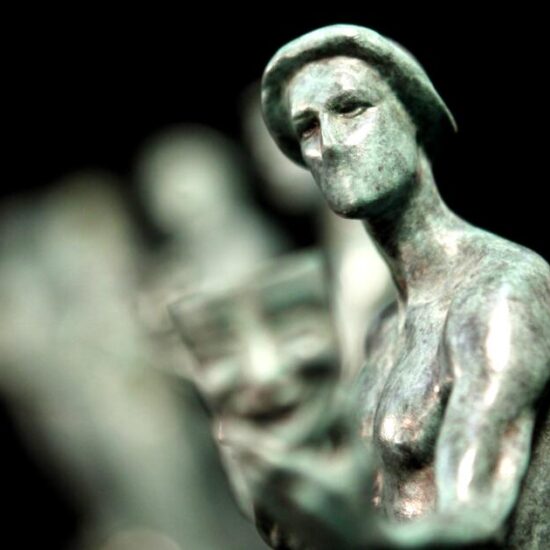In January, Jennifer Croft and Boris Dralyuk were nominated, separately, for the National Book Critics Circle’s Gregg Barrios Book in Translation Prize. This is noteworthy because Croft and Dralyuk are translators of uncommon felicity, Croft of 2018 Nobel Prize recipient Olga Tokarczuk (she is a finalist for Tokarczuk’s “The Books of Jacob”) and Dralyuk of Isaac Babel, among others (he is nominated for Andrey Kurkov’s “Grey Bees”). Also notable: The translators are married, which makes this the first time both members of a couple have been up for the same National Book Critics Circle award. On March 23, they’ll find out whether either takes the prize.
Whatever happens, it won’t define them. They are also acclaimed authors in their own right. Croft’s memoir, “Homesick,” won the 2020 William Saroyan Prize. Dralyuk is a poet and until recently was executive editor of the Los Angeles Review of Books. Last year, the pair left Los Angeles to teach at the University of Tulsa in Oklahoma. We gathered via Zoom to discuss their multifarious work and life.
What’s it like to marry someone in your discipline?
Jennifer Croft: We met because we were both translators of Slavic languages and we had friends in common. Once we started dating, I would find Boris on my steps, where he would tell me about what he had just translated. He gets so emotionally invested. He was at the [L.A. Review of Books], so his time was limited. He was translating 500 words a day. He’s so careful about every word. It was very moving and, I think, a large part of how we came together.
Boris Dralyuk: Jenny — as both a writer and a translator — works more quickly than I do and in big bursts of immersion. One of the inspiring moments of our courtship was reading in one block the almost final manuscript of “Homesick,” and at the same time receiving these very long passages of [Tokarczuk’s] “Flights” and responding with passages of my own. So we courted each other with our projects.
Translation involves inhabiting someone else’s language and work. But it’s also a creative act.
Dralyuk: It’s very much like writing; in fact, it is writing, but you have some help. The plot is there for you, the shades of emotion. But your task is to re-create that by creating something new. You apply the same tools a writer employs, not just the devices but also your psychology.
Croft: Authors have told me translators are their closest readers. That we understand their work better than any other, including editors. Still, unlike many translators, I never consult the writer as I’m working. I feel the text has to be a separate entity. I want it as the original reader would have experienced it.
Lydia Davis once told me about the research that goes into her translations, which includes reading every version of a given work. What do you do?
Croft: I do research, but only in a certain sense. For example, I published a translation of Pedro Mairal — a book called “The Woman From Uruguay,” which charts a journey from Buenos Aires to Montevideo. My research was that I spent seven years living in Buenos Aires and I made that journey many times. This is why I translate contemporary writing, because it is important for me to have lived what is being described. This is why I don’t do — like Boris — historical texts.
Dralyuk: When I began translating, or re-translating, I had every available version open in front of me, along with every dictionary I could find from the period. I’ve scaled that back. I still consult previous translations, but I bring my own diction, my own syntax, my own sense of the original. Just as important is the historical research into the Russian reality of the 1890s or the 1900s, the Soviet reality of 1921.
American culture is notoriously resistant to works in translation.
Croft: There’s still some resistance from editors of a certain generation — to translation itself, to properly crediting and remunerating the translator — but I think people are less phobic than they once might have been. It used to be that people like myself were the most common translators into English — people who grew up speaking English but acquired other languages. Now, a lot of people who have emigrated to the U.S. are bringing their literatures into English. People of color are translating writers of color, which is hugely important. I’m optimistic and excited.
Dralyuk: I share that enthusiasm and optimism. I also feel readers are more ready to accept stylistic innovation on the part of the translator. There has been an over-emphasis, I think, on a very shallow idea of accuracy: “Well, this is wrong, because the original has this word in this place.” That may be fidelity, but it’s fidelity to one element and a betrayal of the whole.
What is the relationship of translating to your other work?
Croft: I’ve always thought of translation as an apprenticeship under a writer I admire. I’ve just completed a novel about eight translators who gather to translate an author’s magnum opus. But the day after they arrive, she disappears. So partly, the book is about translators realizing their agency over the work itself.
Dralyuk: I’m a lover of sui generis voices, which are always threatened with extinction. They can tell us more about their time than any number of homogeneous voices from the same period. I’m also interested in style, sometimes at the expense even of great substance. As an editor, I always worked to help people sound more like themselves, to refine their voices and eliminate false notes.
You’ve recently left Los Angeles for Tulsa — and teaching. How has it been to make that shift?
Croft: I grew up in Tulsa. I thought Tulsa was terribly boring. Then I ended up writing a book about it because I was living in Buenos Aires and realized that Tulsa could be interesting to readers who have no idea what it’s like to hear a tornado coming. Boris was forced to emigrate as a child, and I grew up in a place I couldn’t wait to leave. I lived in Krakow and Warsaw and Moscow and Berlin and Paris and Buenos Aires and New York and then Los Angeles. So for me, it’s a different experience.
Dralyuk: I’ve always thought of teaching as a form of presentation and curation and performance — all the things I put into practice in translation. And in editing too. I’ve loved working as an editor, especially the interaction between author and editor. In the case of students, I feel the relationship is similar. I am helping them to find their voices, their enthusiasm.
Ulin is a former book editor and book critic of The Times.











